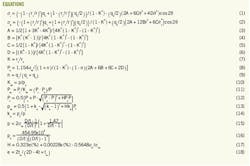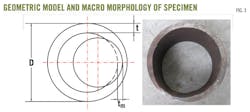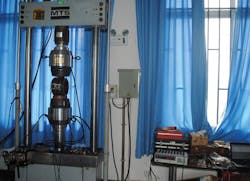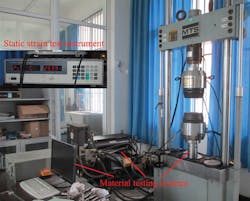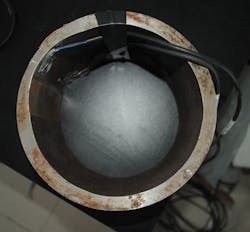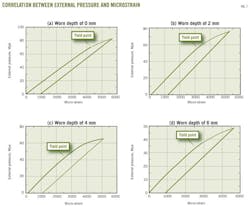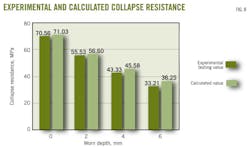Yuanhua Lin
Xing Qi
Kuanhai Deng
Dezhi Zeng
Hongjun Zhu
Dajiang Zhu
Southwest Petroleum University
Chengdu, Sichuan, China
Casing wear is an increasingly typical problem that leads to a decrease in collapse resistance in deep wells, ultradeep wells, horizontal wells, and extended reach wells.
Casing wear can be harmful during drilling and can undermine wellbore integrity during production. It is essential to consider the collapse resistence of worn casing during casing design.
In this article worn casing is described as geometric imperfections in the ovality of the inner wall and nonuniformity of wall thickness, and a new empirical formula is established to compute the collapse resistance of crescent-worn casing under nonuniform loading. Collapse testing has validated the formula.
Calculated results are very close to experimental results, satisfying engineering requirements quite well. The new empirical formula can provide a theoretical basis for casing design in complicated formations.
Introduction
With the dramatic increase in the number of deep, ultradeep, horizontal, and extended reach wells in recent years has followed a rise in the amount of severe wear on the internal surface of casing.
The oil and gas industry probably spends tens of millions of dollars each year on extra casing thickness to allow for wear.1
Fig. 1 shows the macromorphology of worn casing in a wellhead. Once casing wear occurs, it not only leads to a decrease in wall thickness but also greatly reduces the collapse strength, internal pressure strength, and corrosion resistence. Meanwhile, lowering mechanical properties could result in drilling accidents and even lead to premature abandonment.
Most research on collapse resistance for worn casing was concerned with uniform loading, which is an ideal condition. However, casings in complicated formations usually endure nonuniform loading because of formation anisotropy or other engineering factors such as simulation. Several studies have indicated that collapse resistance of casing is reduced greatly under nonuniform loading.2 3
But little research has been carried out on collapse resistance for worn casing under nonuniform loading. This article establishes a new empirical formula for calculating the collapse resistance of worn casing under nonuniform loading. Collapse testing has validated the accuracy of the new formula.
The results indicate that this new formula can provide some references for casing design in complicated formations.
Collapse resistance of ideal casing
After cementing, the casing and cement sheath as well as formation are integrated.
Based on the theory of elasticity mechanics, this kind of problem was assumed as a plane-strain issue. The casing was separated from cement sheath, and this condition is looked on as a nonacentric ideal casing in this model. Hence, the mechanical model of ideal casing under nonuniform loading (Fig. 2c) was deemed to the superposition of uniform loading (Fig. 2a) and elliptic loading (Fig. 2b).
According to theory of elasticity mechanics, the radial stress and tangential stress can be obtained and expressed as Equations 1-7 where A, B, C, and D are trigonometric coefficients of stress function, K is the ratio of inner radius to outer radius, r1 is the inner radius of ideal casing in millimeters, r2 is the outer radius of ideal casing in millimeters, q1 is the casing collapse resistance to uniform loading, MPa, q2 is the casing collapse resistance to elliptic loading in MPa, and q3 is the casing collapse resistance to nonuniform loading in MPa.4
When casing collapse occurs, it is generally considered that stress distribution located on the inner wall of the casing has reached the yield limit of the casing material. Based on the von Mises yield criterion, collapse resistance (Pq) of ideal casing under nonuniform loading can be expressed as Equations 8 and 9 where σYa is the yield strength of the material in MPa and n is the nonuniformity coefficient of the loading.
Collapse resistance of worn casing
Based on research and practical examples,5 6 the contour of most worn casing is referred to as "crescent shape wear" (Fig. 1).
Owing to the existence of larger geometric imperfections, such as the ovality of inner wall, wall thickness nonuniformity, and residual stress, Equation 8 was established only based on an ideal tube. Hence, it was not fit for calculating the collapse resistance of worn casing under nonuniform loading.
In order to obtain a method for calculating the collapse resistance of worn casing under nonuniform loading, the authors studied the characteristics of collapse under different loading models.
We discovered that collapse resistance of worn casing under nonuniform loading will firstly reach the yield point than that of under uniform loading. It was defined as the ratio of stress in worn casing to ideal casing, which stands for the ratio how fast yield onset starts comparing with worn casing, see Equation 10.
Hence, collapse resistance of worn casing under nonuniform loading can be obtained, see Equation 11 where pc was the collapse resistance of worn casing under uniform loading.19
The major cause leading to the reduction of collapse resistance was the increase in geometric imperfections. The geometric imperfections of worn casing can be considered as the superposition of ovality of inner wall and wall thickness nonuniformity in this article. Hence, collapse resistance (pcq) of worn casing under nonuniform loading can be obtained by Equations 10, 11, and 12.
Consider Equation 13 and expressions 14-19 where kp is the elastic-plastic scale factor, Pe is elastic collapse pressure in MPa, p is the yield pressure of ideal casing in Mpa, H is the deviation from worn casing, σR is circumferential residual stress in MPa, ε is eccentricity, e is ovality, D is outside diameter in millimeters, t is casing wall thickness in millimeters, and tm is worn depth.
Therefore, based on Equation 8 and Equations 13 to 19, the collapse resistance of worn casing under nonuniform loading can be calculated.
The new empirical formula for collapse resistance of worn casing under nonuniform loading was established. This new empirical formula not only considered the effects of nonuniform loading and wearing to collapse resistance but also residual stress and ovality as well as eccentricity.
Key experimental equipment and methods
In order to validate the accuracy of the new empirical formula, 7-in. SM-C110 casing was selected for collapse testing.
The casing was internally and locally ground to machining worn casing specimens, which described eccentric wear by 5-in. drillpipe (Fig. 3). Table 1 indicates the dimension and mechanical properties of worn casing specimens.
Collapse testing was performed on the collapse testing system (Fig. 4). The main structure of the collapse testing system including material testing systems (MTS) and static strain test instrument (Fig. 5).
Deformation of casing and external loading exerted on the casing are accurately measured by MTS (Fig. 5). MTS consists of indenter and microcomputer control system as well as hydraulic cylinder. Static strain test instrument is applied to measure the strain of casing in the process of loading.
Two strain gauges were arranged on both ends of the internal wall of worn casing with an interval of 180° to study collapse resistance during testing. The specific location of strain gauges is shown in Fig. 6. The testing data of each strain gauge could be recorded by a static strain test instrument, and corresponding stress could be calculated.
Results and analysis
Fig. 7 shows the correlation between external pressure and microstrain.
The results indicate that the deeper the worn depth, the lower yield pressure; that is to say, the collapse resistance decreases. The collapse resistance values of different worn depth of casing under nonuniform loading also can be obtained from Fig. 7.
It is clearly apparent from Fig. 8 that the collapse resistance values of worn casing under nonuniform loading calculated by the new empirical formula were quite close to experimental testing values. The less the worn depth, the more accurate the calculated result. The error of collapse resistance without wear is 0.67%.
The maximum worn depth is 6 mm, nearly half the wall thickness. Collapse resistance usually is difficult to be obtained accurately, but the new formula provides satisfactory results and its error is less than 10%. It also should be noted in Fig. 9 that collapse resistance of worn casing under nonuniform loading declines rapidly with an increase of worn depth.
References
1. Jerry, P.W., and Dawson, Rapier, "Casing wear: laboratory measurements and field predictions," SPE Drilling Engineering, Vol. 2, 1981, pp. 56-62.
2. Wang, G.H., Chen, Z.M., Xiong, J.Y., and Yang, K.L., "Study on the effect of non-uniformity loading and casing eccentricity on the casing strength," Energy Procedia, Vol. 14, 2012, pp. 285-291.
3. Pattillo, P.D., Last, N.C., and Asbill, W.T., "Effect of non-uniform loading on conventional casing collapse resistance," SPE 79871, 2003, pp. 1-10.
4. EI-Sayed, A.H, and Khalaf, F., "Resistance of cemented concentric casing string under non-uniform loading," SPE 17927, 1992, pp. 59-64.
5. Sakakibara, N., Kyriakides, S., and Corna, E., "Collapse of partially corroded or worn pipe under external pressure," International Journal of Mechanical Sciences, Vol. 50, 2008, pp. 1,586-97.
6. Salehabadi, M., Min, J., and Yang, J.H., "The effect of casing eccentricity on the casing stability analysis of a wellbore drilled in gas hydrate bearing sediments," SPE 131236, 2010.
The authors
Yuanhua Lin ([email protected]) is a professor in the Petroleum Engineering Department in Southwest Petroleum University, Chengdu City, Sichuan Province, China. His work involves research and teaching oil well construction engineering. He holds BS and MS degrees in mechanical engineering and a PhD in drilling engineering from SWPU.
Xing Qi is a postgraduate in the Petroleum Engineering Department at SWPU. His work involves researching new technology and theory of drilling engineering. He has a BS in petroleum engineering from SWPU.
Kuanhai Deng is a doctoral postgraduate in the Petroleum Engineering Department at SWPU. His work involves researching new technology and theory of drilling engineering. He has a BS in petroleum engineering from SWPU.
Dezhi Zeng is a professor in the Petroleum Engineering Department at SWPU. His work involves research and teaching oil well construction engineering. He has BS and MS degrees in mechanical engineering and a PhD in drilling engineering from SWPU.
Hongjun Zhu is a professor in the Petroleum Engineering Department at SWPU. His work involves researching and teaching ocean engineering. He has BS and MS degrees in fluid mechanics from Hohai University.
Dajiang Zhu is a doctoral postgraduate in the Petroleum Engineering Department at SWPU. His work involves researching new technology and theory of drilling engineering. He has BS and MS degrees in petroleum engineering from SWPU.



